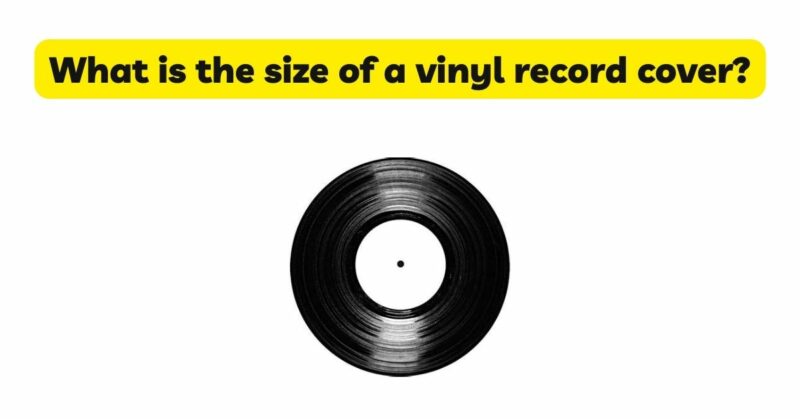Vinyl record covers are an integral part of the vinyl experience, serving as both protective sleeves and visually captivating displays. The size of a vinyl record cover plays a significant role in its functionality and artistic presentation. In this article, we will delve into the dimensions of vinyl record covers, discussing the standard sizes for different formats and exploring variations and exceptions within the industry.
- Standard Sizes of Vinyl Record Covers: The dimensions of vinyl record covers adhere to industry-recognized standard sizes for different formats. The most common standard sizes are as follows:
- 12-inch LP (Long-Playing) Records: The standard size for LP record covers is approximately 12.375 inches (313 mm) in height and 12.375 inches (313 mm) in width. This size allows for larger album artwork, liner notes, and other information to be prominently displayed.
- 7-inch Singles and EPs (Extended Plays): The standard size for 7-inch record covers is approximately 7.125 inches (180 mm) in height and 7.125 inches (180 mm) in width. These smaller sleeves typically contain one or two songs per side and feature more compact artwork and minimal information.
- Importance of Vinyl Record Cover Sizes: The size of a vinyl record cover is of utmost importance as it serves multiple functions. These include:
- Protection: Vinyl record covers are designed to safeguard the vinyl record from dust, scratches, and other potential damage. The cover acts as a shield, preventing physical harm to the delicate surface of the record.
- Presentation: Vinyl record covers serve as a visual representation of the music contained within. They provide an opportunity for artists and designers to create captivating artwork, convey the album’s concept or theme, and evoke emotions. The size of the cover influences how the artwork is displayed and the overall visual impact.
- Information: Vinyl record covers often contain crucial information about the album, such as track listings, credits, lyrics, and additional notes. The size of the cover determines the space available for presenting this information in a readable and aesthetically pleasing manner.
- Variations and Exceptions: While standard sizes exist for vinyl record covers, there are variations and exceptions within the industry. These variations can be influenced by factors such as regional preferences, special editions, artistic visions, and collector’s editions. Some examples of variations and exceptions include:
- Gatefold Covers: Gatefold covers are double-wide album sleeves that fold open, revealing additional artwork, photographs, or supplementary content. These covers adhere to the same height as standard covers but have a width of approximately 24.75 inches (628 mm) when unfolded.
- Miniature and Shaped Covers: Some releases, particularly limited editions or special releases, feature smaller or uniquely shaped covers. These variations deviate from the standard sizes and can range from miniature replicas of the standard cover to custom shapes that reflect the album’s concept or theme.
- Box Sets: Box sets often contain multiple vinyl records packaged together in a larger box or slipcase. The size of the box or slipcase can vary depending on the number of records included and the design choices made by the artist or label. These variations allow for more extensive artwork and elaborate packaging.
- Picture Discs: Picture discs are vinyl records with an image or artwork embedded between two transparent vinyl layers. The size of the picture disc cover may vary depending on the chosen design and artwork, but it generally adheres to the standard dimensions.
- Design Considerations: When designing vinyl record covers, it is crucial to consider the standard sizes to ensure compatibility and consistency within the vinyl record industry. Artists, graphic designers, and record labels should take into account the specific dimensions and aspect ratios to optimize the visual impact of the artwork and text. This ensures that the cover fits appropriately within the standard sleeve and provides a cohesive experience for vinyl collectors and music enthusiasts.
- Protection and Preservation: To protect and preserve vinyl record covers, it is advisable to use high-quality materials and archival-grade protective sleeves. These protective sleeves shield the covers from dust, moisture, and potential damage while allowing for easy access to the records. Additionally, proper storage practices, such as keeping the records upright in a controlled environment away from direct sunlight or extreme temperatures, contribute to the long-term preservation of the covers.
- Evolving Trends and Artistic Freedom: While adhering to the standard sizes provides consistency and compatibility, the vinyl record industry continues to evolve with new trends and artistic expressions. Some artists and labels intentionally push boundaries and experiment with unique cover designs, unconventional sizes, or limited editions to offer collectors distinctive and memorable experiences. These deviations from the standard sizes add diversity and creative flair to the vinyl record landscape.
Conclusion: The size of a vinyl record cover is an important aspect of its functionality and visual presentation. Standard sizes exist for different vinyl formats, with LP covers typically measuring approximately 12.375 inches (313 mm) in height and width, and 7-inch single covers measuring approximately 7.125 inches (180 mm) in height and width. While these standard sizes provide consistency and compatibility, there are variations and exceptions within the industry, including gatefold covers, miniature or shaped covers, box sets, and picture discs. Designing within the standard sizes and utilizing protective sleeves contribute to the longevity and enjoyment of vinyl record covers. As the vinyl record industry continues to evolve, artists and labels have the opportunity to explore new trends, break conventions, and offer collectors exciting and diverse experiences through innovative cover designs.

